Caring for chickens in winter (small flock)
This post contains affiliate links. Please read my disclosure policy.
A Guide to Keeping Your Small Flock Happy and Healthy
Caring for chickens winter can be a challenging. Especially when you live in a colder climate like I do. Here are five things I do to keep my small flock of chickens healthy and happy during the dark, cold days of winter in north Idaho.
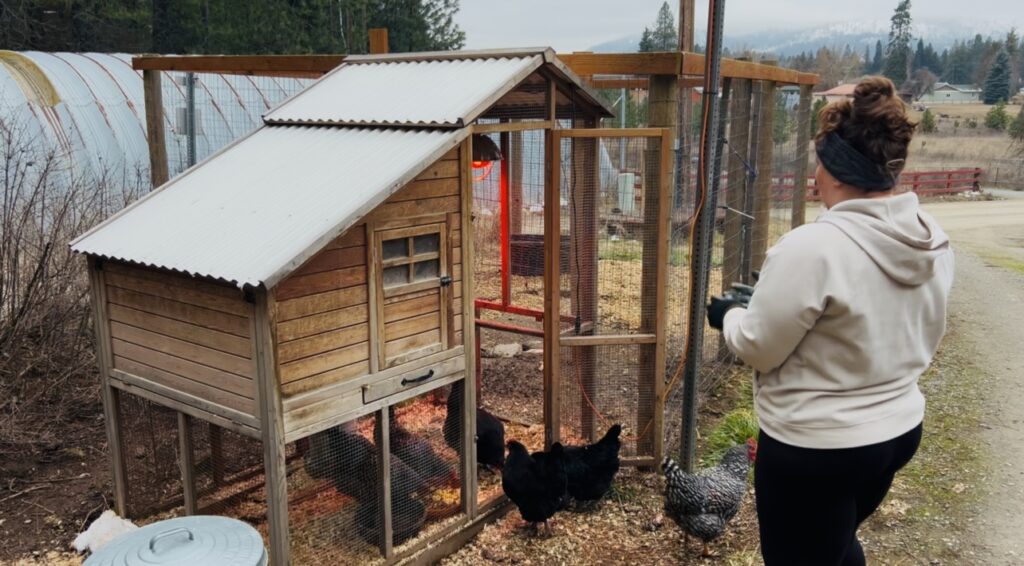
1. Providing Warmth Without Overheating
Chickens naturally run a little hotter. Their body temperature typically runs between 105 and 107 degrees. Whew! Compare that to our human 98.6 degrees and they are downright toasty. Which means they can adapt pretty well to cold temperatures. That being said you still want to make sure they don’t get too cold especially when temps drop below freezing. To help my flock stay warm, I use a red light heat lamp in the coop.
The red light is great because it provides a gentle radiant heat that doesn’t disrupt their natural sleep cycles. Using a white light works as well and I have used both. I find the red light gives off a little more heat. Using a red light instead of a white light can effect egg production. The white light tends to help keep the chickens laying regularly during the shorter days. With a red light they still might slow down egg production slightly. Just keep that in mind when picking a heat light. I hang the lamp safely away from flammable materials and ensure it’s securely mounted to prevent accidents.
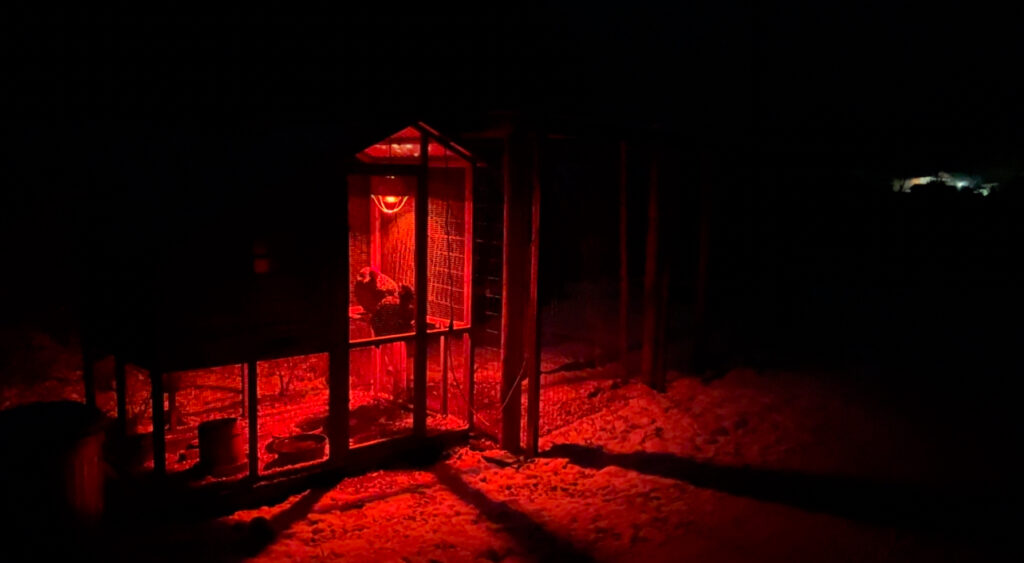
As you can see with my coop there is a smaller enclosed hutch and the rest of the coop is open to the air. This is where I have the heat light because there simply isn’t room for it in the hutch. Even with it being in the open area of the coop it still gives off enough heat that the chickens benefit. On a windy day it might be as effective but chickens are pretty adaptable and still do ok. It’s good to let your chickens acclimatize to the cold weather so I don’t use a heat lamp for them until the temps drop to the low 30’s. If you don’t let them acclimatize then any extreme changes in temperature will have more of a negative impact on them.
Keep in mind that you also don’t want your chickens to overheat. If you have an enclosed coop make sure there is some airflow and monitor the air temp in the coop. Around 40 degrees Fahrenheit is ideal.
2. Maintaining a Clean and Dry Coop
Keeping a clean, dry coop is a must in the winter. For my little flock of 7 chickens that means cleaning out the coop every two weeks. I could probably stretch it a little beyond that but I try not too. Along with not being good for the chickens, going to long also means it’s much harder to clean out the coop especially once temps are below freezing.
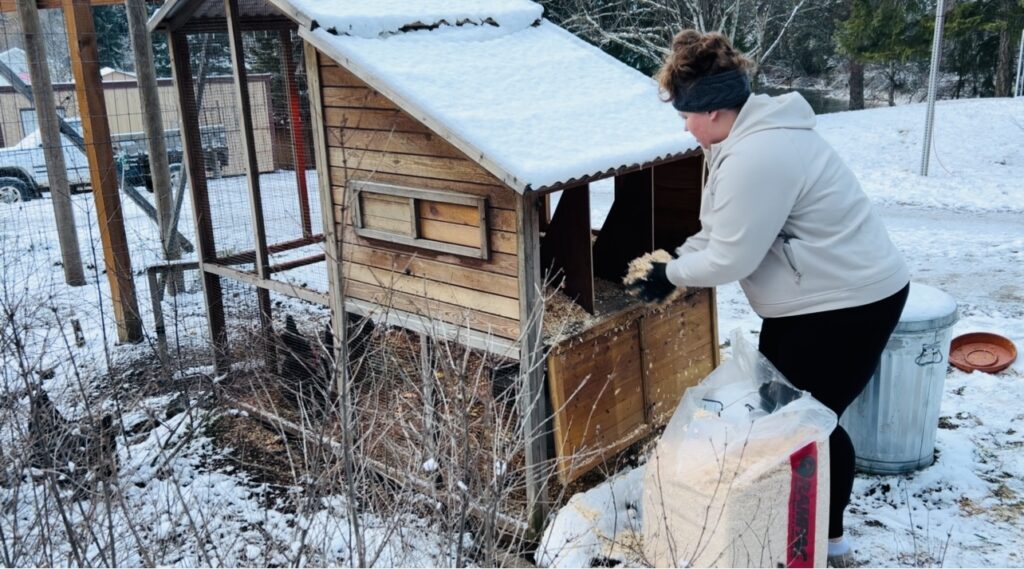
Up in the hutch where some of the chickens sleep and also where the nesting boxes are I use pine shavings for the bedding. This has been the only bedding I have ever used and it works great. I like to make it pretty deep and the girls will move it around to their liking.
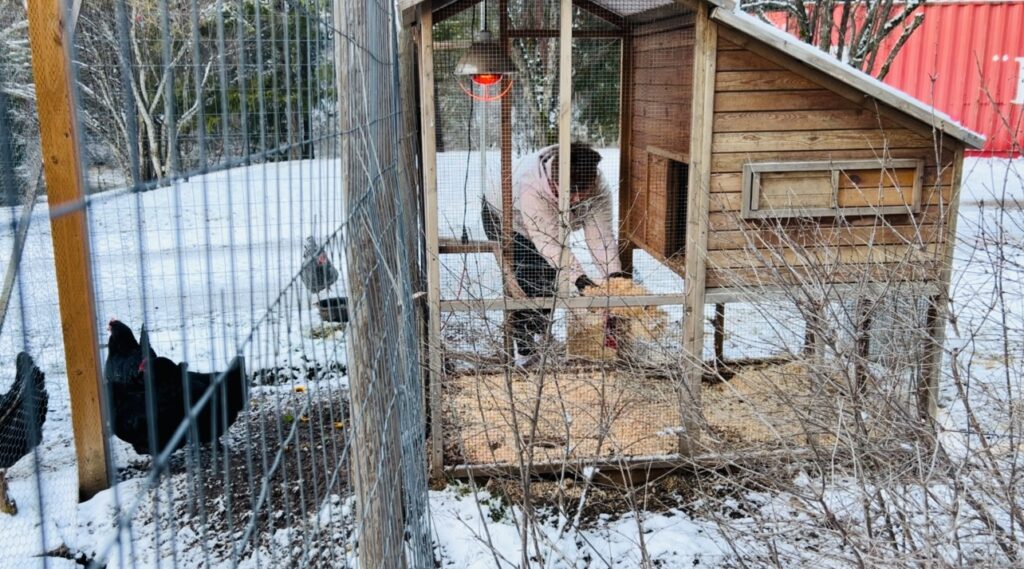
In the lower part of the coop I will also put a layer of shavings at the same time I clean out the hutch. This is where I keep their food and water. This makes a nice dry, warm spot for them to eat and drink without their feet being in the freezing cold mud. In the spring we will move the coop and shovel out all that’s accumulated in this area over the winter. Using fresh pine shavings often also keeps the odor down and keeps the air in the coop healthier for the chickens.

3. Feeding for Energy and Warmth
Proper nutrition is also essential in winter, as chickens burn more calories to stay warm. Along with their regular pellet feed I like to supplement their food with lots of kitchen scraps and other tasty, nutritious snacks.
Chickens eat just about any scraps that come out of the kitchen. I keep a bowl or pot in the kitchen where we toss all our kitchen scraps and take it out to the chickens daily. I offer them a variety of vegetable peelings, stale bread and other leftovers. Kitchen scraps to avoid giving chickens are raw potatoes and potato skins, apple seeds and cherry pits, avocado pits, skins and leaves, chocolate or spoiled food.
A warm treat I like to give them is a simple mixture of oats and hot water. No need to cook the oats, just put them in a chicken safe dish and pour hot water over them. Let them sit for a few minutes and give them to the chickens.
When I have extra eggs, I will scramble them up and give them to the chickens. While that might seem strange to be giving scrambled chicken eggs to chickens they are an excellent source of extra protein during the cold winter months. Sometimes I will throw them in with the oat mixture and top it all with a couple handfuls of black fly larvae.
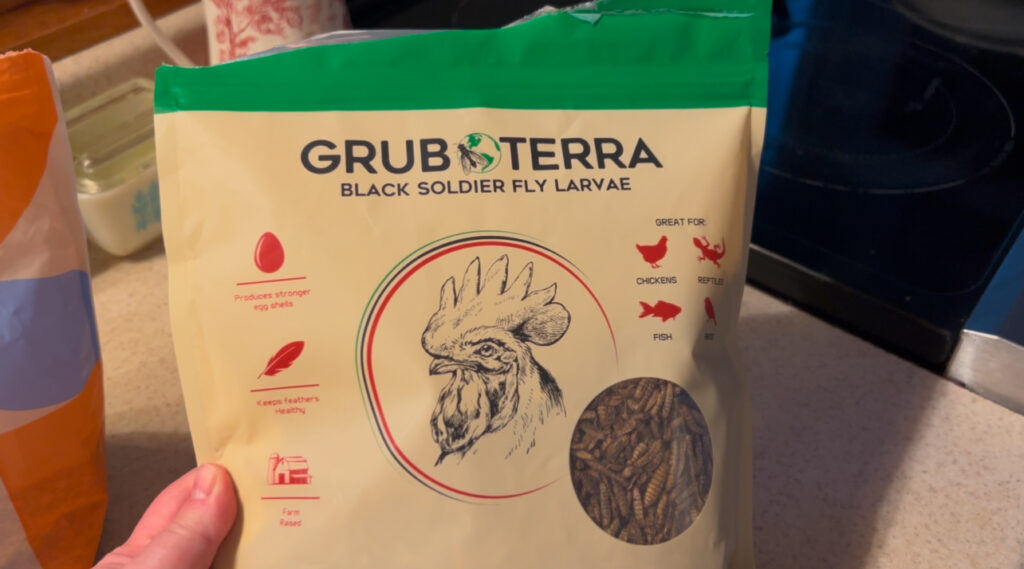
I supplement their feed with GrubTerra Dried Black Soldier Fly Larvae. The black fly larvae contains extra protein which helps support egg production during winter. It also contains fat, fiber, calcium, lysine and phosphorous. GrubTerra Dried Black Soldier Fly Larvae have been proven to increase egg production in laying hens, helps reduce molting times, and creates stronger egg shells. It is sustainably raised in the USA, Costa Rica and Indonesia and packaged in the USA. Not to mention my chickens absolutely love them! Follow the link below and use the code Homespun10 at checkout for 10% off your first order.
Use this link and enter code Homespun 10 at checkout for 10% off your first order.
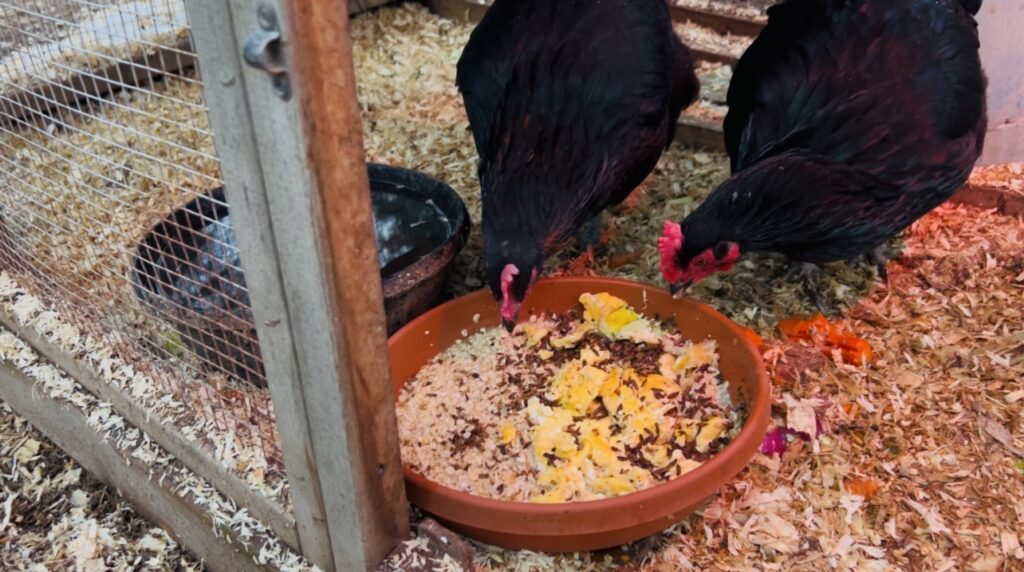
4. Encouraging free-ranging
During the cold winter months I encourage my chickens to free range as much as possible when there is no snow. Once we have a couple inches (or more!) of snow on the ground they no longer want to leave the coop so making sure they get out while they can is really important. Even though they aren’t going to find any bugs they are still able to eat up whatever little bits of green are left. It also lets them stretch their legs and get out of the mud that is in their chicken run and garden area. They love foraging, scratching and exploring and it gives them a nice change of scenery during the darker winter days.
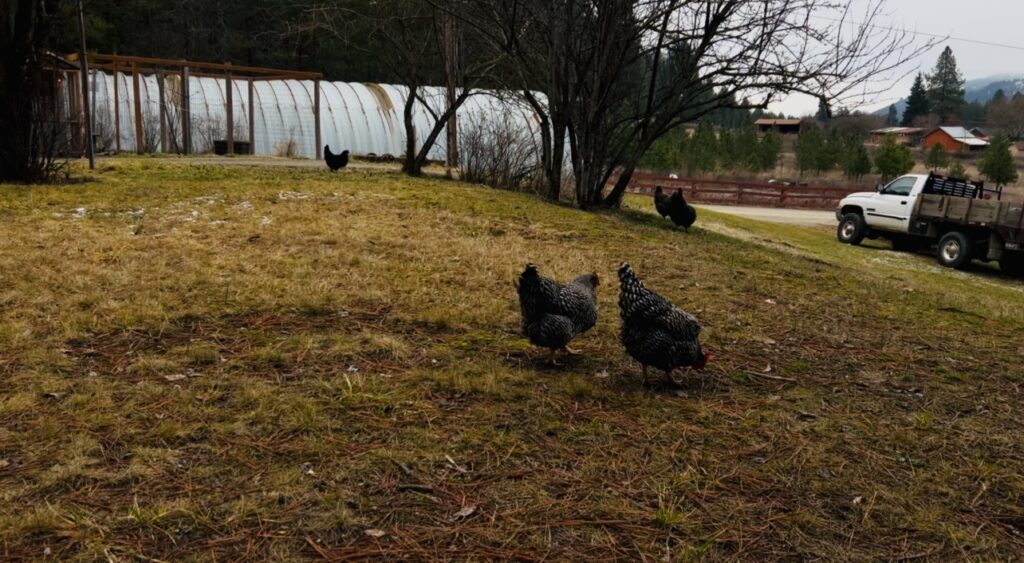
Once it does snow I try to keep at least a little area clear of snow for them to get out of the coop. Sometimes this works, sometimes it doesn’t.
5. Preventing Frozen Water and Ensuring Hydration
Having access to water at all times is crucial to keep your chickens happy and laying regularly. In winter it can get tough because water will freeze when temperatures dip below freezing. Because I don’t have a heated waterer I make sure to check their water a couple times a day to break the ice and/or give them some fresh, hot water. Some day I will purchase one a heated waterer but for now checking on their water a couple times a day works great too.

Taking care of your chickens in winter, especially in colder climates, takes a little bit of extra work but is really not too hard. Doing these five things will help keep your chickens happy in the winter and laying all year round.
Pin for later!
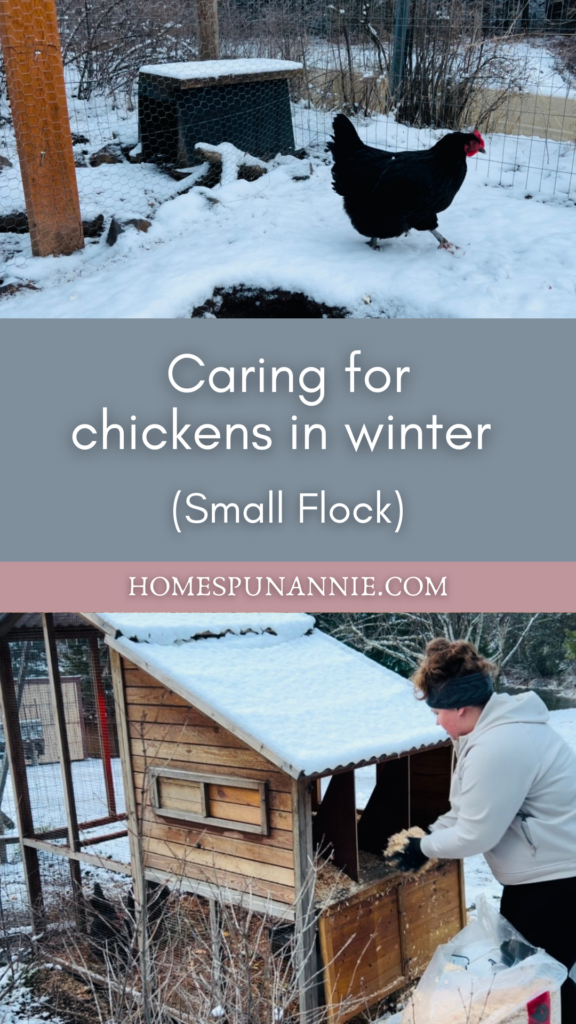
Check out my YouTube channel and subscribe! www.youtube.com/@homespunannie

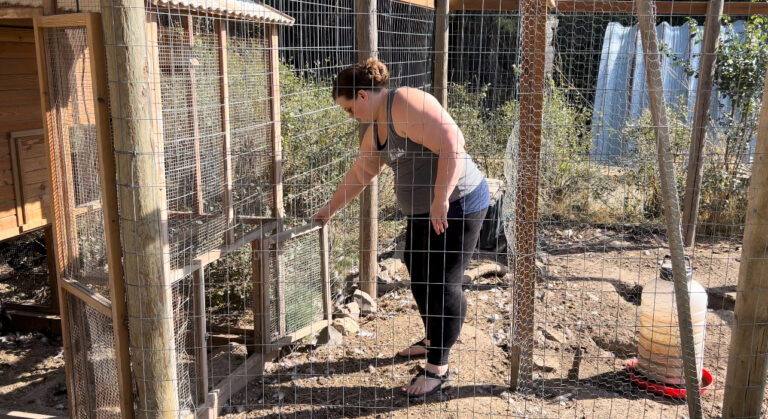
Great information! I didn’t realize that those soldier fly larva have so many benefits for the chickens, I’ll have to try that. I found a bunch of them drowned in my goat water buckets last fall. Thank you for sharing!